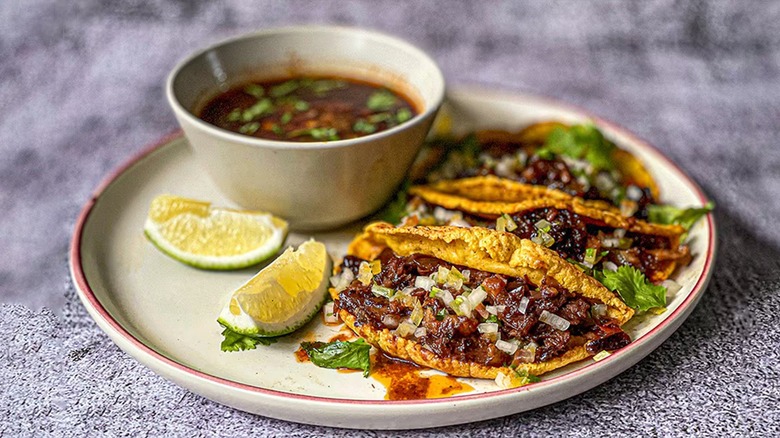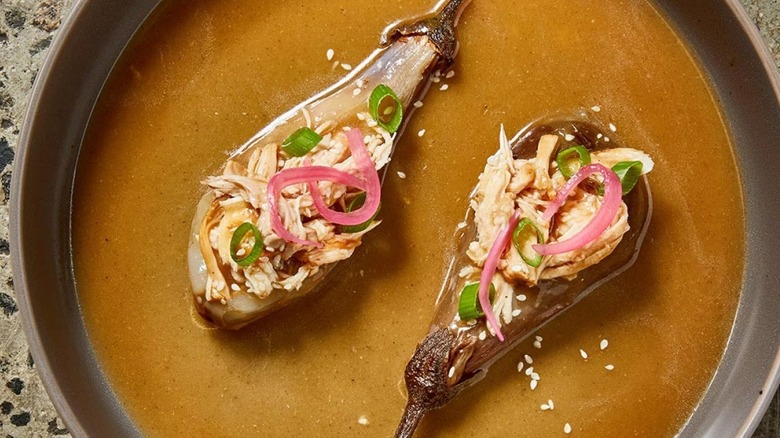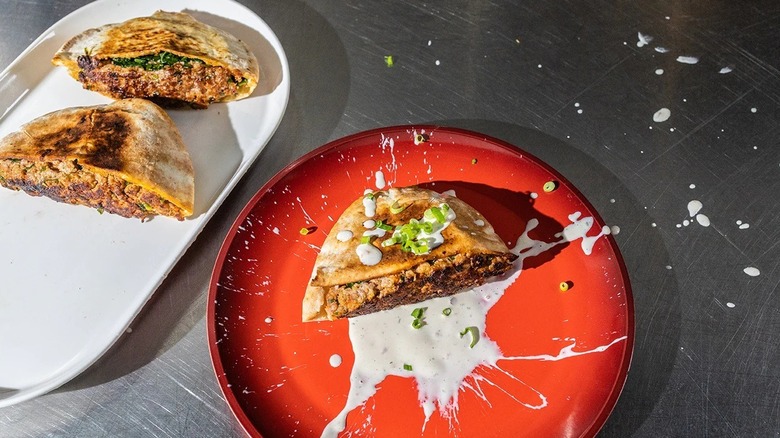The Biggest Food Trends On Plates Right Now – Chefs Are Exploring Their Culinary Roots
Sponsored Content. We may receive a commission on purchases made from links.
It should come as no surprise that change is a prevalent theme for Future Menus, Unilever Food Solutions' annual roundup of the biggest food trends of the year. After all, diners are always craving something new and exciting, and that insatiable hunger for the next big thing is a driver for exciting evolutions in food and beverage.
Future Menus Vol. 3 certainly lives up to that expectation, identifying four prominent trends right now – Street Food Couture, Borderless Cuisine, Diner Designed, and Culinary Roots. You may remember from previous Food Republic articles that Street Food Couture captures the demand for elevating classic street food dishes from countries such as Mexico, India, South Korea, and the Philippines to exciting new boundaries of taste (and social media notoriety). Borderless Cuisine celebrates the ever-expanding international cross-pollination of ingredients and cooking techniques, and Diner Designed is inspired by innovations such as AI and new levels of personalization. This article focuses on Culinary Roots, a trend that seems to take a U-turn from the road to tomorrow to recognize a growing taste for nostalgia, with chefs honoring their cultural heritage by preparing traditional recipes made with indigenous ingredients.
While these dishes may be familiar regionally, their proliferation is opening a whole new audience of diners looking to explore cuisines that are brand new to them but carry a rich history. While celebrating the past, chefs are also bringing a sense of self into these classics, infusing a modern spin on familiar favorites without sacrificing their cultural identity.
Finding new flavors through hyper-regional cuisines
Whether it's the never-ending lines at Michelin-starred Yucatan seafood specialist Holbox in Los Angeles or the increasing demand for khao soi and funky sour sausages from Northern Thai specialists in New York City, restaurants are no longer being defined simply by their country of origin. Imagine dining overseas and stumbling across an "American" restaurant. What exactly would that signify? Burgers and fries? Cajun and creole? Tex-Mex? Even a focus on domestic barbecue – would that highlight Hill Country beefiness? The porcine perfection of the Carolinas? Some Kansas City sweetness?
Diners are becoming wise to the reductiveness of casting a wide net on a nation's cuisine, and according to Unilever Food Solutions Corporate Executive Chef Brandon Collins, the reason is twofold. He credits online research and social media influence, particularly during the pandemic, to increasing education on hyper-regional cuisines, which provide an introduction to new flavors and cooking techniques.
Collins also notes that a craving for homestyle comfort food is spurring immigrant communities across the world to bring a taste of the motherland to their new home. "I think that's kind of where we started seeing chili crisp, salsa matcha, birria," he says. "Those sorts of flavor profiles that at one point in time were hyper-regionalized and hyper-local are now becoming ubiquitous all across the landscape."
How chef Ana Roš sticks to her culinary roots
While social media and globalization have helped facilitate the sharing of cuisines around the globe, nothing beats going straight to the source. The picturesque town of Kobarid in western Slovenia may not seem like an obvious tourist destination, but foodies have been making the pilgrimage there to savor a meal at Hiša Franko, the three Michelin-starred restaurant helmed by Ana Roš. The self-taught chef made a name for herself (and Slovenian cuisine) emphasizing bold flavors using high-quality, locally-sourced ingredients.
"For me, Culinary Roots is about returning to nature," said Roš. "It's about embracing the local territory and being mindful in how we garden and forage, so we don't deplete the forests or meadows."
During her keynote address at the Future Menus Vol. 3 kickoff party, Roš shared this ethos by preparing one of her signature dishes: the 1 euro potato. Each top-notch tuber (the name refers to the price paid to the farmer for each single potato), plucked from the soil not too far from her restaurant, is baked in a hay crust. The result is the embodiment of roots cooking, offering the essence of Kobarid in a simple yet spectacular package.
Traditional with a twist
Let's face it: No matter how hard you try, that delectable Sunday gravy grandma used to make just can't be beat. Whether it's changes in skill level, equipment, or accessibility of ingredients, replicating a dish across generations is a tall order. So when it comes to the notion of authenticity, the expectations of providing a facsimile need to be left at the door as long as the soul of the dish remains intact.
With that in mind, chefs are sticking to their Culinary Roots by preparing dishes that respect the past while bringing in their own personal twist. "Old techniques like escabeche are being modernized – it's about creativity and reinvention," says Peio Cruz, Lead Chef Unilever Food Solutions. His grilled eggplant stuffed with chicken escabeche, miso & sherry stays true to the traditional Spanish method of stewing a protein in a vinegar base (a technique used for preservation purposes) while adding new flavors into the fold.
When Phillip Li, Executive Chef Unilever Food Solutions, China, decided to do a healthier take on beef with Sichuan chili oil by swapping in fish, he stayed true to the original version in all but protein. "Young chefs must respect the traditional dish," says Li.
Culinary Roots at home: Cajun rice & gravy arayes recipe
Unilever Food Solutions Corporate Chef Cori Bourdreaux's version of Cajun rice & gravy arayes is a tasty example of broadening your Culinary Roots. "I wanted to update this classic dish into something fun and handheld while keeping true to its original spirit," he says. The result is Cajun rice & gravy arayes which maintains all the familiar elements of the Bayou standard while incorporating Lebanese-inspired portability courtesy of a griddled pita pocket. This inexpensive and delicious recipe is easy enough to make in your home kitchen.
INGREDIENTS
(SERVES 6)
Rice and Gravy
2 lbs pork shoulder, cubed
2 tbsp Cajun seasoning
3 tbsp vegetable oil
1 yellow onion, sliced
1 green pepper, diced
2 ribs of celery, diced
5 garlic cloves, minced
1 qt Knorr Professional Ultimate Vegetable Liquid Concentrated Base
2 g Knorr Professional Au Jus Roast Beef Gravy Mix
Collard greens
2 qt collards greens, shredded
2 tbsp vegetable oil
2 tsp Cajun seasoning
¼ yellow onion, diced
½ green bell pepper, finely diced
3 garlic cloves, minced
¼ cup water
.5 tbsp Knorr Professional Ultimate Vegetable Liquid Concentrated Base
Meat filling
1 lb ground beef
1 tbsp Cajun seasoning
.5 tbsp Knorr Professional Chicken Liquid Concentrated Base
½ yellow onion, grated
½ green bell pepper, grated
¼ scallion, thinly sliced
Parsley, minced
Tahini Ranch
1 c Hellmann's Real Mayonnaise
1 c buttermilk
1.5 tbsp Hellmann's Original Buttermilk House Dressing Dry Mix
½ c tahini
2 tbsp lemon juice
¼ green onion, sliced
Arayes
Rice & gravy
Collard greens
Meat filling
2 cups white rice, cooked
6 pitas, cut in half
1.4 cup vegetable oil
METHOD
Rice & Gravy
-
Toss pork with seasoning and let rest overnight. Brown pork in oil over medium low heat until well browned all over, then remove pork and add onion, bell pepper, and celery.
-
Sweat vegetables until onions are translucent, then add garlic and cook until fragrant. Add pork and stock. Bring to a boil, reduce to a simmer, cover, and cook until pork is tender – appx 60-90 minutes. Stir occasionally.
-
Add demi glace and stir well. Continue simmering until pork separates easily with a fork. Defat, separate meat from gravy, then chill.
-
Tip: This is tastier if made the day before.
Collard greens
-
Sweat vegetables in oil until onions are translucent. Add garlic and seasoning, cook until fragrant.
-
Add collard greens, water, and base. Stir and cook over medium-low heat until greens are tender and most water has been cooked out, appx 10-15m.
-
Tip: If greens aren't tender, add water a little at a time to continue cooking.
Meat filling
-
Place onion and pepper into cheesecloth or similar and squeeze out as much liquid as possible. Combine squeezed vegetables and all other ingredients in a bowl and mix well.
Tahini Ranch
-
Combine ranch mix with buttermilk. Mix well.
-
Add remaining ingredients. Mix well then refrigerate.
Arayes
-
Combine rice with reserved gravy until desired level of coating is achieved.
-
In each pita half, place appx 2-3 tbsp of rice mixture, then some of the cooked pork, then some of the collard greens. Top pita with appx 1.5oz of the raw meat mixture, being sure to cover the entire opening.
-
Over medium-low heat, cook pitas in oil on both sides before finishing by cooking vertically with the raw meat contacting the pan. Pitas should take on lots of color and meat should be very well browned. Serve with tahini ranch for dipping.





